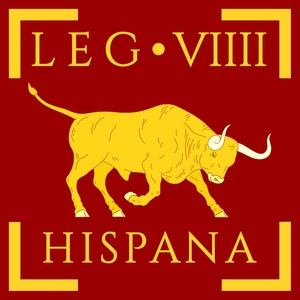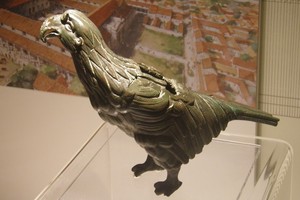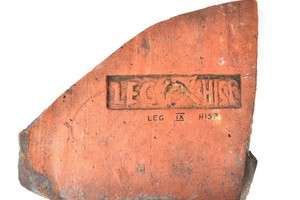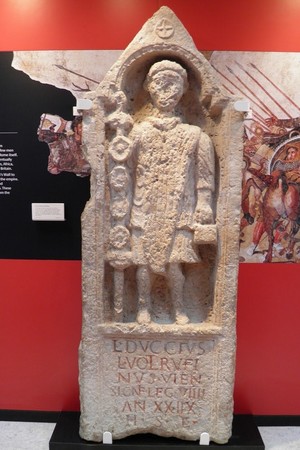Roman Legion - Legio IX Hispana
Legio IX Hispana (Ninth Spanish Legion) was a combat unit of the regular Roman army, existing from the 1st century BC until 120 AD.
Dates of existence: 65 BC - Last mention of the legion dates back to 120 AD, although there are versions suggesting that parts of the legion participated in later campaigns.
Symbol: Bull
Nickname: Hispana (Spanish)
Battle Path
- The exact date of the legion's creation is unknown, but author Stephen Dando-Collins, in his book "Legions of Rome," believes the legion was created in the mid-1st century BC by Gnaeus Pompey the Great in Spain, then transferred to Italy in 65 BC to protect Northern Italy from the raids of the Illyrian tribes. Throughout its history, the legion marched from Spain to Britain, where it is believed to have perished in its final battle.
- Later, Pompey handed it over Gaius Julius Caesar for the Gallic Wars (58-60 BC) in Gaul, where the legion actively fought in 58 BC. In the Civil War between Caesar and Pompey (49-45 BC), the legion supported Caesar. During the civil war, the legion participated in the battles of Ilerda (49 BC), Dyrrhachium (48 BC), and Pharsalus (48 BC).
- In 46 BC, Caesar rewarded the legionaries with land in Istria and Picenum, subsequently disbanding the legion.
- After Caesar's assassination, in 41 BC, his successor Octavian Augustus reformed the legion, which actively participated in the war between Caesar's supporters and his assassins.
- In 25 BC, Emperor Augustus sent the legion against the Spanish tribes. It earned its nickname "Spanish" during its time in Spain.
- After spending 12 years in Spain until 13 AD, the legion was moved to the Rhine River, although there is no information about Legio IX Hispana's participation in any campaigns in this area.
- In 9 AD, the legion was stationed in Pannonia, camped at Savia (modern Sisak, Croatia). Later, Legio IX Hispana appears among the legions that participated in the conquest of Britain in 43 AD during Emperor Claudius's reign. During the British campaign, the legion became a permanent garrison in Britain, becoming the first legion permanently stationed in the new province.
- From 52 to 57 AD, the legion was commanded by legate Caesius Nasica, who is believed to have been the elder brother of the next legate of the legion, Quintus Petillius Cerialis (31-83 AD). Cerialis commanded the legion during the Boudican revolt in Britain and was sent with his legion to suppress it in 61 AD, as the main Roman forces in Britain were engaged in a military campaign on the island of Anglesey. In the battle for the first capital of the province, Britannia (Camulodunum), parts of the IX legion were defeated and retreated, allowing the rebels to destroy the city. The legion retreated to the continent, replenished its ranks due to heavy losses, and was then returned to Britain.
- In 65 AD, Legio IX Hispana was camped in Lincoln (a city in eastern England), then moved to Eboracum (modern York, England). In 70 AD, the legion again actively participated in the war with British tribes in Britain, where it remained camped.
- In 78 AD, Legio IX Hispana participated in a military campaign against the Brigantes chieftain Venutius, who was defeated along with Legio XX Valeria Victrix. The legion was then sent to fight the Chatti tribe in Germany, and by 108 AD, it was again moved to Britain to a camp near York, where it built a fortress. The legion is still mentioned under Emperor Hadrian in 117 AD, after which information about the legion ceases.
- The last mention of the Ninth Spanish Legion in Britain is an inscription from 108 AD on a stone in York, England, which is now in the York Museum.
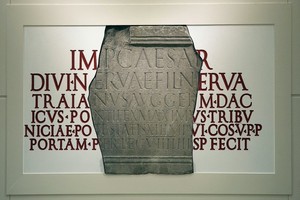 The last mention of the Ninth Spanish Legion in Britain is an inscription from the year 108 on a stone in York, England, which is now in the York Museum.
The last mention of the Ninth Spanish Legion in Britain is an inscription from the year 108 on a stone in York, England, which is now in the York Museum.Theories on the Disappearance and Demise of the Legion
- Theory 1: Legio IX Hispana was destroyed by Britons and Celts in northern Britain while attempting to suppress another revolt of British tribes against the Romans in 117 AD.
- Theory 2: Legio IX Hispana was transferred from Britain to Judea shortly before the Bar Kokhba revolt (132-135 AD), during which it was destroyed.
- Theory 3: Legio IX Hispana was transferred from Britain for wars in the East, where it was destroyed by the Parthians in Iran in 161 AD. There is no precise information on what happened to the legion and why it disappeared from the lists of Roman legions after 122 AD.
Related topics
List of Roman Legions, Legion, Legionnaire, Legio VIII Bis Augusta, Legio X Fretensis, Gnaeus Pompey the Great, Gaius Julius Caesar, Octavian Augustus
Literature
- Kanya R. "Legion".
- Roman Glory. Ancient military art.
- Dando-Collins "Roman Legions. The Complete History of the Roman Legions"
